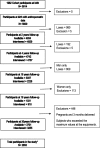Overweight trajectory and cardio metabolic risk factors in young adults
- PMID: 30857546
- PMCID: PMC6410517
- DOI: 10.1186/s12887-019-1445-3
Overweight trajectory and cardio metabolic risk factors in young adults
Abstract
Background: Obesity is one of the conditions that increases the risk of cardiovascular disease. Studies about obesity trajectory and cardio metabolic outcomes at adulthood are still scarce. Therefore, we aimed to assess the association between patterns of overweight over the life-course and cardio metabolic risk factors in young adults.
Methods: In 1982, the maternity hospitals in Pelotas were visited daily and those newborns whose family lived in the urban area of the city were identified (n = 5914), and have prospectively followed for several occasions. Weight and height were measured at every visit. BMI-for-age z-score was calculated using the WHO Child Growth Standards. Overweight and obesity were defined as a BMI greater than or equal to 25 kg/m2 and 30 kg/m2 respectively. This was the definition adopted for evaluations overweight and obesity at 30 years. The participants were divided into eight groups according to the presence of overweight or obesity in childhood, adolescence and adulthood. Blood pressure, random blood glucose, HDL cholesterol, LDL cholesterol triglycerides and fat mass were measured.
Results: From 2219 participants with anthropometric data in childhood, adolescence and adulthood, 25% never had been overweight, whereas 11.6% were overweight in the three periods. Random blood glucose, SBP and DBP were higher among those subjects who were always overweight/ obese or only overweight/obese during adolescence and adulthood. The participants who were never overweight/obese or only in childhood or adolescence had a lower cardiovascular risk profile (higher HDL cholesterol, lower blood pressure, lower random glucose, lower LDL cholesterol) at 30 years. Fat mass captured from 25 to 100% of the association of overweight and obesity trajectory with cardiometabolic risk factors.
Conclusions: The tracking of overweight/obesity is associated with an adverse cardio metabolic profile and this association is largely mediated by fat mass in adulthood.
Keywords: Cardiometabolic risk factors; Obesity; Trajectory; Young adults.
Conflict of interest statement
Ethics approval and consent to participate
Verbal consent was obtained from those responsible for the children in the initial phases of the study (1982–1986), as was the common practice at that time, when there was no ethics committee at the Federal University of Pelotas. In the next phases, the Medical Ethics Committee of the Federal University of Pelotas approved the study protocol and all follow-ups of the Pelotas 1982 Birth Cohort Study. Participants signed a consent form on behalf of them at each follow-up, after being informed of the study objectives.
Consent for publication
Not applicable.
Competing interests
The authors declare that they have no competing interests.
Publisher’s Note
Springer Nature remains neutral with regard to jurisdictional claims in published maps and institutional affiliations.
Figures
References
-
- World Health Organization. Global status report on noncommunicable diseases 2014. World Health Organization. http://www.who.int/iris/handle/10665/148114. - PubMed
-
- Romero-Corral A, Montori VM, Somers VK, Korinek J, Thomas RJ, Allison TG, et al. Association of bodyweight with total mortality and with cardiovascular events in coronary artery disease: a systematic review of cohort studies. Lancet. 2006;368(9536):666–678. doi: 10.1016/S0140-6736(06)69251-9. - DOI - PubMed
-
- Mendis SPP, Norrving B. Global atlas on cardiovascular disease prevention and control. Geneva: World Health Organization; 2011.
Publication types
MeSH terms
Substances
Grants and funding
LinkOut - more resources
Full Text Sources
Medical
Molecular Biology Databases


